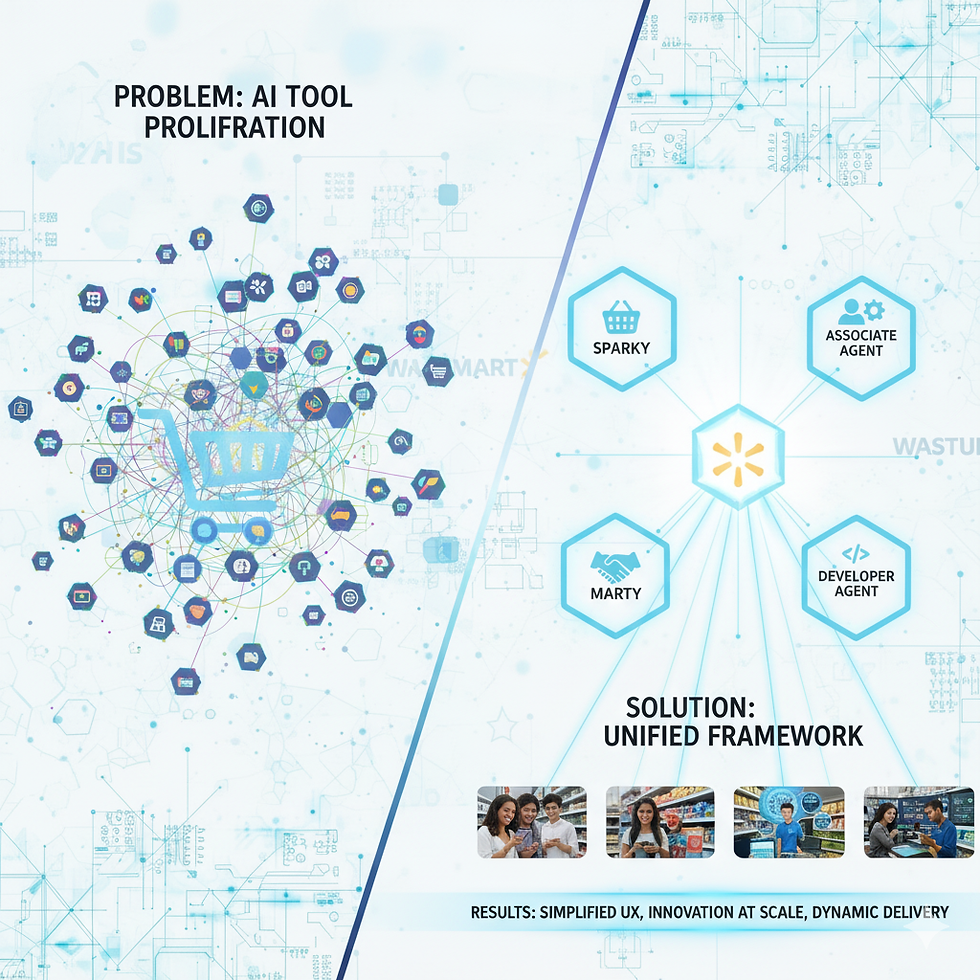Lessons from Walmart's Four AI Agent Architecture
- Evangel Oputa
- Sep 11
- 3 min read
Walmart revealed how they transformed from AI tool chaos to strategic clarity and the results offer a roadmap every enterprise can follow.
In this post, we will break down Walmart's shift from multiple disconnected AI agents to four unified "super agents" that serve their customers, associates, and partners. You will discover the exact framework they used and how to apply these lessons to avoid the same costly mistakes in your organization.
TL;DR: Walmart's Four-Agent AI Strategy
Walmart solved AI tool chaos by consolidating multiple scattered agents into four "super agents":
Sparky (customers) - Shopping assistant in Walmart app
Associate Agent (employees) - Schedules, sales data, benefits in one place
Marty (partners) - Supplier/advertiser onboarding and campaign management
Developer Agent (tech teams) - Streamlined testing, building, launching
The Problem: Teams built many useful AI agents, but they became "overwhelming and confusing"
The Solution: "Unified, company-wide framework" with specialized agents nested under the four main entry points
The Result: Simpler adoption, better integration, plans for dynamic delivery to 95% of U.S. households by year-end
Key Takeaway: Organize AI around user personas (customer, employee, partner, developer) rather than technical functions. Build frameworks that make adoption easier, not harder.

The Problem: When Useful Tools Become Overwhelming
Walmart Global Tech faced a challenge every large organization knows well. Teams were building AI agents rapidly, and each one delivered value.
But success created a new problem.
As CTO Suresh Kumar admits: "Multiple agents, even if each one is useful can quickly become overwhelming and confusing."
Walmart recognized that individual tools, no matter how helpful, weren't enough. They needed consolidation, not proliferation.
The Solution: Four Strategic Super Agents
Instead of managing multiple specialized tools, Walmart consolidated around four "intelligent, intuitive entry points" that cover their entire ecosystem:
Sparky (Customer Shopping Agent) - Already live in the Walmart app, helping customers find what they need quickly and intuitively. Soon, it will power reordering, seamless support and shopping that feels more effortless.
Associate Agent - Brings everything into one place, from schedules to sales data, saving time and letting teams focus on what matters most.
Partner Agent (Marty) - Helps suppliers, sellers, and advertisers manage onboarding, orders and campaigns.
Developer Agent - Speeds up how they test, build, and launch, enabling innovation at scale across Walmart.
Each super agent is supported by specialized agents, some already in use, like an agent that helps associates navigate benefits and an agent that helps merchants analyze sales trends.
The Process: Building Unity Without Losing Specialization
Walmart's approach centers on what they call a "unified, company-wide framework" designed to ensure every new agent makes life simpler for everyone.
Their strategy includes:
Super agents as entry points while maintaining specialized functionality underneath
Organization around user types - customers, associates, partners, and developers
Continued development of specialized agents that live within the super agents
Integration with breakthrough tech like drones and real-time digital twins of facilities
The key insight: build architecture that makes adoption easier, not harder.
The Outcome: From Tool Chaos to Competitive Advantage
Walmart's consolidated approach is already delivering results:
Simplified user experience - Four clear entry points instead of scattered tools
Enhanced functionality - Super agents will become more visible while specialized agents continue developing underneath
Advanced capabilities - Plans to offer dynamic delivery windows to 95% of U.S. households by the end of year.
Strategic positioning - Moving beyond "better bots" to "building a smarter Walmart"
As Kumar states: "This is about more than better bots. It's about building a smarter Walmart, one that sets new standards for speed, precision and service."
Key Takeaways for Your AI Strategy
Recognize when proliferation becomes a problem. Even useful tools can become overwhelming when they multiply without coordination.
Build frameworks, not just features. Walmart invested in a unified infrastructure that makes every new agent simpler to deploy and use.
Organize around users, not functions. Four super agents aligned with customer, associate, partner, and developer needs create intuitive access points.
Plan for specialization within consolidation. Super agents can house specialized tools while maintaining a consistent user experience.
Think beyond individual tools. Focus on creating systems that set new standards for your industry.
"We are not just adopting the tools of the future, we're shaping them, leading with them and putting them to work for our customers, our partners and one another." — Suresh Kumar, CTO/CDO, Walmart
Ready to Transform Your AI Strategy?
Want to see results like Walmart's in your organization?
Schedule your AI strategy session now and discover how to consolidate your tools into a unified, scalable framework that drives real business results.




Comments